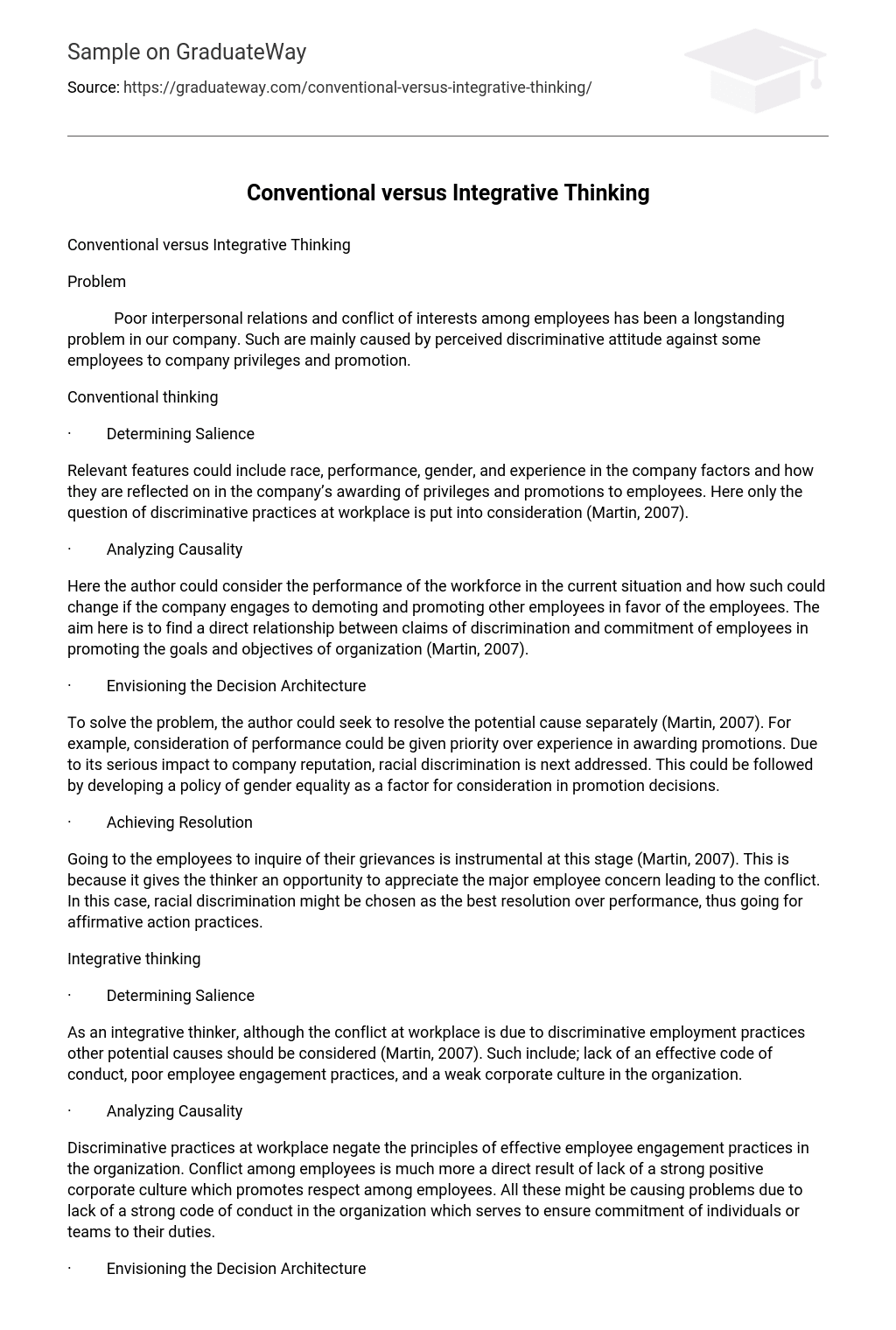Problem
Poor interpersonal relations and conflict of interests among employees has been a longstanding problem in our company. Such are mainly caused by perceived discriminative attitude against some employees to company privileges and promotion.
Conventional thinking
· Determining Salience
Relevant features could include race, performance, gender, and experience in the company factors and how they are reflected on in the company’s awarding of privileges and promotions to employees. Here only the question of discriminative practices at workplace is put into consideration (Martin, 2007).
· Analyzing Causality
Here the author could consider the performance of the workforce in the current situation and how such could change if the company engages to demoting and promoting other employees in favor of the employees. The aim here is to find a direct relationship between claims of discrimination and commitment of employees in promoting the goals and objectives of organization (Martin, 2007).
· Envisioning the Decision Architecture
To solve the problem, the author could seek to resolve the potential cause separately (Martin, 2007). For example, consideration of performance could be given priority over experience in awarding promotions. Due to its serious impact to company reputation, racial discrimination is next addressed. This could be followed by developing a policy of gender equality as a factor for consideration in promotion decisions.
· Achieving Resolution
Going to the employees to inquire of their grievances is instrumental at this stage (Martin, 2007). This is because it gives the thinker an opportunity to appreciate the major employee concern leading to the conflict. In this case, racial discrimination might be chosen as the best resolution over performance, thus going for affirmative action practices.
Integrative thinking
· Determining Salience
As an integrative thinker, although the conflict at workplace is due to discriminative employment practices other potential causes should be considered (Martin, 2007). Such include; lack of an effective code of conduct, poor employee engagement practices, and a weak corporate culture in the organization.
· Analyzing Causality
Discriminative practices at workplace negate the principles of effective employee engagement practices in the organization. Conflict among employees is much more a direct result of lack of a strong positive corporate culture which promotes respect among employees. All these might be causing problems due to lack of a strong code of conduct in the organization which serves to ensure commitment of individuals or teams to their duties.
· Envisioning the Decision Architecture
Therefore, the problem causing employee conflict should be a direct result of the company’s governance structure (Martin, 2007). By encouraging equal employment opportunity without employee engagement practices, commitment of employee to work as a team remains a challenge. This is further complicated by the failure to define and enforce and effective code of conduct to dictate the behavior of individual employees and managers in conducting their duties.
· Achieving Resolution
By identifying the relationship between company structures and employee conflict, the decision will be made reflecting actual and potential causes to the problem (Martin, 2007). In such a situation reviewing of the company’s corporate culture policies remains the best resolution to the problem. The new culture should encompass equal employment policy, clearly defined employee code of conduct, and a policy on employee engagement practices.
Conclusion
Though both approaches might address the situation, integrative thinking gives a long-term solution (Martin, 2007) which serves to redefine the corporate culture of the organization to reflect the social, economic and psychological expectations of the workforce. This is important in promoting commitment and teamwork towards realization of the goals and objectives of the organization.
Work cited
Roger Martin, “How Successful Leaders Think,” Harvard Business Review. June 2007.





